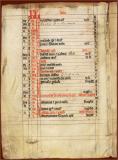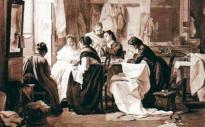L' histoire de Metz et de la Lorraine, histoire de la moselle - cartes postales anciennes de Metz - cartes postales anciennes de Moselle - histoire Moselle

Maison N°25, Rue Taison
Mrs REMY Barbe, an embroideress by her trade, practised her art at number 25, rue Taison, in 1809.
There is no profession whose history was more intimately related to the one of painting, in particular in Occident. If embroidery has now lost its greatness and this since the late 16th century, one should not forget that painters had been the auxiliaries of the embroiderers for long: the latter used to paint with their needles the pieces of
composition that the painters had first sketched using their paintbrush, and which they had made detailed representations of.
The apprenticeship used to last eight years, and each master or mastress was allowed to have only one apprentice-embroiderer (or apprentice-embroideress) at a time. This long apprenticeship guaranteed that all the processes of the art were handed down from workers to workers.
The profession kept itself prosperous until the 17th century; then several by-laws forbade the abuse of embroideries and gold ornaments in costumes, and the brodeurs-chasubliers (embroiderers chasuble makers), this is the name the statutes gave them in 1648, were left with no choice but to dedicate their skills almost exclusively to fashioning chasubles and other religious ornaments. Through their embroideries, the workers, in the 17th and 18th centuries, tried most of all to reproduce the style of the most renowned laces of that time; such as the point de Hongrie and the Saxon lace. Being made sometimes with hands and sometimes with the loom, the first one, which was longer and more difficult to produce, was always favoured.
Here are the terms (in French) that, in the 18th century, referred to the most common kinds of broderies (the French for embroidery):
- broderie à deux endroits or broderie passée, a work that implied to trace the exact same drawing on the two s
ides
of the fabric;

ides
Cliquez sur le mon pour plus de détails.
- broderie appliquée, made on a big canvas, that was then cut up in order to sew it on another fabric;
- broderie en couchure or broderie dor et dargent (gold and silver embroidery): the same matters were also used for the broderie en guipure; but, in order to make this one, one had to start with drawing on the very fabric, then one would cut out vellum following the form of the drawing, and then sew it on gold, with silk;
- broderie plate, decorated with flakes, and broderie en chenilles de soie, whose most common use was for the priestly ornaments.
These are the main kinds of embroideries that used to be made when the corporation was suppressed. Even if, in terms of processes and ability of the labour, the embroiderers had improved, an examination, even mot much attentive, of their creations shows in which state of inferiority they were, by comparison with their predecessors: embroidery was not an art anymore, but a craft.


